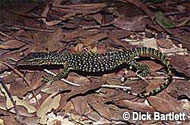Description:
The mangrove monitor is semi-aquatic and arboreal by nature, spending much of their time in or near water. Captive mangrove monitors need a warm, humid, spacious cage with branches for climbing and basking and a large water container for swimming and soaking. Hide boxes or other shelters are also recommended for the mangrove monitor species. Captive mangrove monitors will consume fish, frogs, lizards, snakes, eggs, mice, small rats and canned cat or dog food. Mangrove monitors require temperatures ranging between 82 and 90 degrees Fahrenheit, with a warmer basking spot (up to about 95 or 97 degrees Fahrenheit). Nighttime temperatures can be lowered to around 70 or 75 degrees Fahrenheit. A thermal gradient is recommended.
The mangrove monitor is semi-aquatic and arboreal by nature, spending much of their time in or near water. Captive mangrove monitors need a warm, humid, spacious cage with branches for climbing and basking and a large water container for swimming and soaking. Hide boxes or other shelters are also recommended for the mangrove monitor species. Captive mangrove monitors will consume fish, frogs, lizards, snakes, eggs, mice, small rats and canned cat or dog food. Mangrove monitors require temperatures ranging between 82 and 90 degrees Fahrenheit, with a warmer basking spot (up to about 95 or 97 degrees Fahrenheit). Nighttime temperatures can be lowered to around 70 or 75 degrees Fahrenheit. A thermal gradient is recommended.
Habitat:
Warm, humid areas. In trees near rivers and streams.
Range:
Throughout the Mariana, Caroline, Marshall and Solomon Islands; as well as Celbes, Timor, New Guinea and northern Australia.
Scientific Name: Varanus indicus
Species Group: monitor
Family: Varanidae
Size: Moderate in length, with most adults averaging between 2½ and 4 feet in total length.
Level: advanced
Weight:
Dangerous: No


